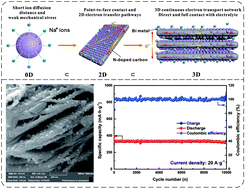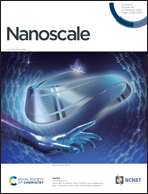A multi-layered composite assembly of Bi nanospheres anchored on nitrogen-doped carbon nanosheets for ultrastable sodium storage†
Abstract
Bismuth (Bi) is a promising anode candidate for sodium ion batteries (SIBs) with a high volumetric capacity (3765 mA h cm−3) and moderate working potential but suffers from large volume change (ca. 250%) during the sodiation/desodiation process, resulting in pulverization of the electrode, electrical contact loss, excessive accumulation of solid electrolyte interfaces, etc., devastating the cycling stability of the electrode seriously. Addressing this issue significantly relies on rational micro- and nano-structuring. Herein, we prepared a 3D multi-layered composite assembly of Bi/carbon heterojunctions with 0D bismuth nanospheres distributed and anchored on 2D nitrogen-doped carbon nanosheets (NCSs), using a preorganization strategy by taking full advantage of the strong complexation ability of Bi3+. The multi-layered composite assembly is periodic and close-packed, with Bi nanospheres <25 nm, carbon nanosheets ∼30 nm, and an average interlayer space of ∼75 nm. Such a specific architecture provides abundant electrochemically active surfaces and ion migration channels as the Bi nanospheres are attached to the 2D nitrogen-doped carbon nanosheets via a point-to-surface pattern. Moreover, the mono-layer Bi nanospheres oriented along the 2D-surface of NCSs are kinetically favorable for the recognition of Na+ by the active sites of Bi nanospheres as well as for avoiding the long distance migration of Na+ (external diffusion of Na+). Furthermore, thermodynamically, the small size and high surface energy of ultrasmall Bi nanospheres could contribute to high ion mobility (internal diffusion of Na+) and promote electrochemical reactions as well. The multi-layered composite assembly of Bi@NCSs (ML-Bi@NCSs) not only provides a robust 3D framework guaranteeing the whole structural stability but also ensures direct and full contact of each active nano-building block with electrolyte, thereby forming a high-throughput electron/ion transport system. When evaluated as the anode for SIBs, ML-Bi@NCSs deliver superior high-rate capability up to 30 A g−1 (specific capacity: 288 mA h g−1) and long-term cycling stability (capacity retention: 95.8% after 5000 cycles at 10 A g−1 and 90.6% after 10 000 cycles at 20 A g−1, respectively).



 Please wait while we load your content...
Please wait while we load your content...